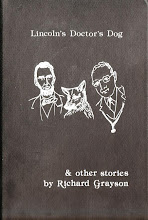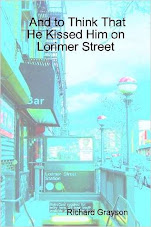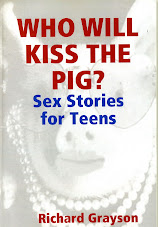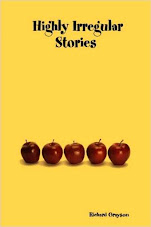
We headed over to the Old Stone House in Washington Park on a dreary fall Sunday afternoon to see a first-rate production of John Osborne's
Look Back in Anger.

It was precisely the play needed for a dreary Sunday, as it has three crucial scenes set on dreary Sundays. But this drama's effect is the direct opposite of dreary. It's explosive.

We bought the Bantam paperback edition of the play from the old Bookworm Bookstore on Flatbush Avenue near Church when it came out in 1967.

We stayed up one night and read the play in one long gulp.

The book had amazing drawings of the scenes by Lee Gregori. But of course it was Osborne's words, even a decade after they caused a revolution on the London stage, in the mouth of his "angry young man," Jimmy Porter, that so excited one 16-year-old boy in Brooklyn:
I've an idea, why don't we have a little game? Let's pretend that we're human beings and that we're actually alive. Just for a while. What do you say?

The contemporary reaction to
Look Back in Anger is more respectful than enthusiastic. It's impossible, given the past forty or fifty years, to recapture the response its got back in the day when it seemed urgent, an emancipation of drama from the restrictions of past generations, particularly in pre-Beatles, pre-mods-and-rockers, pre-"cool-Britannia" Britain, but also in fifties America.
Even by the time we read it, we'd already digested -
devoured - Albee's
Who's Afraid of Virginia Woolf?, in which the emotional outbursts are even more extreme than the ones that are
Look Back in Anger's most compelling moments.

The second floor of the Old Stone House is a great space for talks and the
Brooklyn Reading Works but it's not ideal for theater. Yet this production, directed fluidly by Thomas Mulhare, managed to employ the space to maximum effect, effectively using the intimacy; at several points, sitting on the aisle, we could have reached out and touched the characters. Scene changes, which could have been jarring, were handled adeptly in an understated way with a character simply announcing them: "Two weeks later."
The cast was uniformly superb. The dialogue written by Osborne (for some reason, the program misspelled the author's name four times, adding a superfluous U, as if it were
labour, honour or
colour - but we guess it's great that that was our biggest quibble with the production) contains a number of monologues that could lend themselves to scenery-chewing. But here everything was controlled, restrained - even at the moments of highest rage and passion.

Alex Mills played Jimmy Porter with a vulnerability that made his sneering and sadistic tirades directed at his wife Alison and the other characters understandable. Mills' performance also emphasized Jimmy's high intelligence and educated background, which serve only to feed his frustration and bitterness and make him strike out at the world, including those who - almost unaccountably but not quite - love him. But he's also delighted with his own fury.
Yet it's hard in 2009 to take Jimmy's long, vicious riffs - like those against his despised mother-in-law - with the kind of shock that it generated decades ago. Look
Back in Anger is one of those artistic works at the vanguard of so triumphant a revolutionary change that its innovations are impossible to discern for an audience who didn't live through its initial reception.

Today it's hard to imagine how some of us were affected by Osborne's plays - we also loved
The Entertainer - and other groundbreaking British novels, dramas and films of the time: Shelagh Delaney's
A Taste of Honey, John Schlesinger's
Billy Liar, anything by
Alan Sillitoe.
Our dad once came in as we were viewing
Loneliness of the Long Distance Runner for about the seventh time one week on Channel 9's
Million Dollar Movie and said with a chuckle, "No matter how many times you watch it, he's never gonna finish that damn race." So we were thrilled to have this production come to the Old Stone House this weekend and delighted to get this kind of quality theater for just a five-dollar donation.

There's a tenderness in this Jimmy Porter that makes his unpleasant egotism understandable but doesn't veer into mawkishness. Alex Mills perfectly captured Osborne's stage directions' description of his antihero as "a disconcerting mixture of sincerity and cheerful malice, of tenderness and freebooting cruelty."
In the squalor of Jimmy's Midlands flat - subtly suggested by a minimalist set, lots of newspapers scattered about (we admit being distracted by their being New York papers; maybe they could have gotten some London ones?) and a few stuffy furnishings, including an old record player from which very low-key background music which served the action of the play well - Alison, his upper-class wife, at first seems out of place.

Played by Katy Foley, who also was the producer here, this Alison seemed less Jimmy's punching bag and doormat than someone who's somewhat willingly taken on the role of wife as victim as a way of protecting the man she loves from turning his anger on himself. That is, Alison here appears very vulnerable but not bewildered; she's made her choices deliberately, even though she may not be aware of it. In Foley's portrayal, you can see why Alison is the squirrel to Jimmy's bear in their stuffed-animal avatars on a side table.
As Helena, Ruby Joy at first is outwardly brittle and somewhat manipulative, but in Act Two - there was a ten-minute intermission - it's obvious that she wears a protective armor and is also a lost soul, drowning slowly in what she once thought were safe waters. She doesn't lack compassion, but for Joy's Helena, everything else takes a back seat to self-preservation.

Daniel Kemper excelled as Cliff and was in some ways the pivotal character in this production. Jimmy's most ardent passion is devoted to his loyal crony Cliff, who's fiercely protective of him despite the mutual insults. Cliff is even more protective and tender toward Alison, whom he's so affectionate toward - the choice made to begin the play with Cliff and Alison in an embrace, as if they're having a furtive affair, was brilliant - that it would arouse the jealousy of any husband except Jimmy, who's incapable of jealousy.
Tolerant, patient, self-deprecating, funny, acutely aware of his limitations and lack of education, Kemper's Cliff is also quite needy, and we don't quite know how to respond to his perfectly-delivered speech announcing that it might be time for him to move on from Jimmy's sweet shop business and his friends' menage; this character's motivations are in some way the most complex in the play.

Like Jimmy's working class English accent and the posher accents of the other characters, Cliff's Welsh accent was effectively unobtrusive and unaffected.
Dan Odell as Colonel Redfern, Alison's father, gave an affecting performance as the representative of the establishment, no caricactured Colonel Blimp but a man plagued by self-doubt and second-guessing, as vulnerable as the young people, distracted and bewildered by the ground shaking underneath Old England's feet. In the way he muddles through, there's a sense of decency about him, and Odell struck all the right gestures for a man of his time and place.
 Look Back in Anger
Look Back in Anger is a period piece today, and this production emphasized not its blazing fury but the melancholy underlying the characters' lives. Osborne's words, even the ones that seemed vulgar and brutal in 1956, now seem elegaic and wonderfully poetic.
The sun was shining as we left the Old Stone House and we were really glad we got to see this production.


































































































